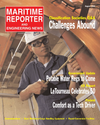
Page 28: of Maritime Reporter Magazine (August 2005)
AWO Edition: Inland & Offshore Waterways
Read this page in Pdf, Flash or Html5 edition of August 2005 Maritime Reporter Magazine
During the early 1950's, offshore drilling was, for the most part, limited to non-mobile (fixed) platforms that were embedded in the sea floor by permanent foundations and/or pilings. The use of these non-mobile platforms was an expensive proposition since recovering the cost of the foundation had to be achieved from a single drilling location.
The very few mobile platforms operat- ing during that era were supported by sunken refloatable vessels, and were considered unsuitable for use in the tur- bulent waters of open seas and, there- fore, confined to inland waters.
R.G. LeTourneau, an inventor, innova- tor, and pioneer (with literally hundreds of U.S. patents) had an idea for a vessel that could safely drill for oil and gas off- shore. During a career that had spanned nearly 40 years, LeTourneau had become renowned for designing and building machines that elevated the earthmoving industry to new levels of efficiency and productivity. He was the first to develop all-wheel electric drives for these heavy-duty machines, a key technological component in the success- ful development of a mobile offshore drilling platform.
LeTourneau envisioned a stable and secure mobile platform that could safely operate in often-treacherous open waters. He knew that such a vessel would greatly reduce the costs of off- shore drilling by being able to move from site-to-site rather than being per- manently fixed to one location. His company, R.G. LeTourneau, Inc., after conducting extensive engineering stud- ies in oceanography, hurricane winds, and tidal waves, began design work on a mobile, self-elevating offshore drilling platform. The objective was to build an all-weather offshore drilling platform that could be floated to the drill site then quickly converted to a stabilized struc- ture by lowering open lattice tripod-type support legs to the sea floor.
Although the concept of a deep-sea, mobile, offshore platform aroused con- siderable interest among the oil compa- nies, none were prepared to help finance the construction of such an expensive (nearly $3 million) and unproven proj- ect. That is until LeTourneau proposed the idea to Zapata Off-Shore Company of Houston, Texas, headed by future
United States President, George Bush.
Bush later described LeTourneau in his autobiography, Looking Forward. "A kind of George Patton of engineer- ing. … He'd come to us with a proposi- tion: he'd build the Scorpion at his own expense. We'd advance him $400,000 - refundable if the completed rig didn't work; if it did, he'd get an added $550,000 and 38,000 shares of Zapata
Off-Shore common stock. Our feeling was that anybody who had that much confidence in himself was worth the gamble."
The contract to deliver the first mobile offshore platform was signed on
November 11, 1954 and construction began in late 1954 near the company's
Vicksburg plant on the shores of the
Mississippi River. With the need to overcome the design constraints of con- ventional platforms, its construction was considered by many in the offshore oil industry to be quite a daring attempt.
The LeTourneau Mobile Offshore
Platform was basically a large, shallow- draft barge, equipped with three electro- mechanically-operated lattice type legs.
Dimensions of the platform were 186 feet long, 150 feet wide, and 24 feet in section with a 24-foot by 28-foot derrick slot.
The hull structure comprised two 20- foot diameter barge-like hulls, which were reinforced by corrugated steel plate and utilized for fuel storage, mud tanks, and water supply storage. The three 140-foot lattice type steel legs (also known as spuds) were located on two sides and one end of the hull.
Living quarters for the crew and heli- copter landing pads were fitted to the deck.
In December 1955, the 4,000-ton plat- form "walked" into the Mississippi
River under its own power.
Construction of the platform was com- pleted with the installation of a drilling derrick, pumps, and associated equip- ment.
The platform was handed over to
Zapata Off-Shore and officially chris- tened "Scorpion" on March 20, 1956 in a ceremony where R.G LeTourneau pre- sented a three-foot "Key to the Gulf" to
Zapata's president, George Bush.
Scorpion went into service off the coast of Port Aransas, Texas and drilled its
U.S. Report 28 Maritime Reporter & Engineering News
LeTourneau Celebrates 50th Anniversary of the First Jack-Up Rig
Scorpion on location in the Gulf of Mexico.
R.G. LeTourneau, George Bush and Dick LeTourneau.
MR AUGUST 2005 #4 (25-32).qxd 8/4/2005 6:01 PM Page 28

 27
27

 29
29
